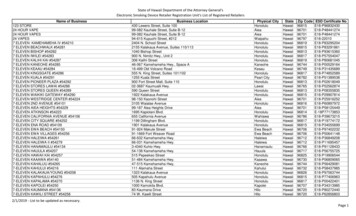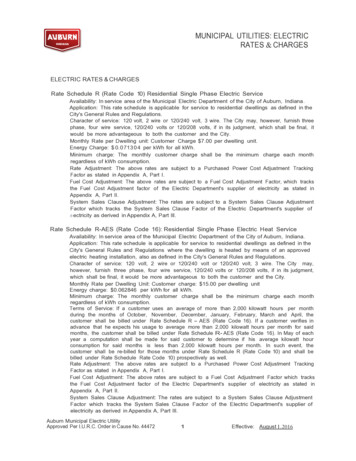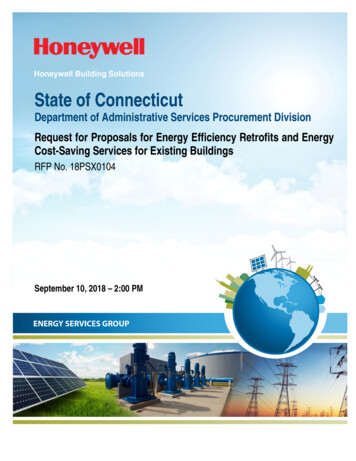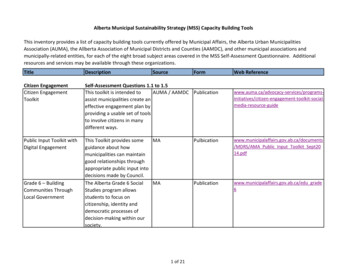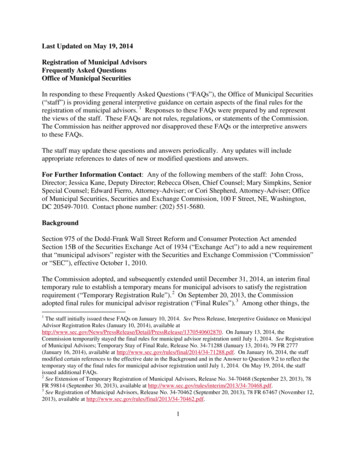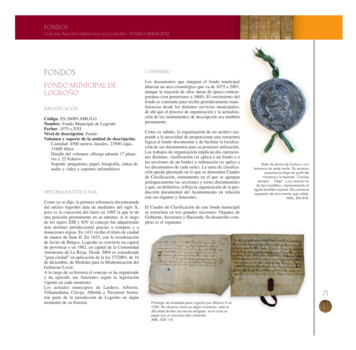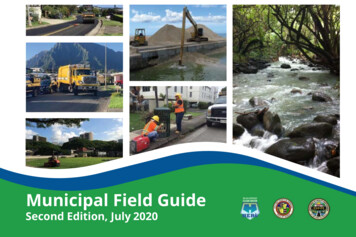
Transcription
Municipal Field GuideSecond Edition, July 2020
Purpose of Field GuideThis Field Guide is intended to be a quick reference on storm water Best Management Practices (BMPs) to be usedby municipal maintenance staff during infield activities. By implementing BMPs during field activities we can preventand reduce storm water pollution and help improve overall water quality. For facility-related activities (work insidefacility boundaries) and BMPs, please refer to the site-specific plans developed for each facility.This guide is divided into six tabs which are grouped by related activities. General BMPs are provided followed bycommon field maintenance activities and task specific BMPs. For quick reference, “ ” and “ ” marks have beenadded to pictures to indicate if the control measure shown is a good or bad example of proper installationand maintenance.Municipal Activity BMP Info Sheets are referenced for each maintenance task to provide additional information andguidance on source control measures. The Activity BMP Info Sheets can be found in the Municipal MaintenanceStorm Water BMP Manual located in the City’s website cleanwaterhonolulu.com. At the end of the Field Guide areuseful telephone numbers of various City departments, State, and Federal agencies.Environmental Quality Control – ROH Section 14-12.23Know the laws and implement storm water BMPs during your daily tasks to prevent pollutants from enteringthe storm drain system and polluting our waters. The Revised Ordinances of Honolulu, Section 14-12.23(a),Environmental Quality Control-Violation states:“It shall be unlawful for any person to discharge or cause to be discharged anypollutant into any drainage facility which causes a pollution problemin state waters, or causes a violation of any provision of the City NPDES(National Pollutant Discharge Elimination System) permit or the waterquality standards of the State of Hawaii.”2Cover photo credits: 1. (Top left) CCH DRM Paving East Manoa Road 2. (Middle left) CCH Refuse Collection in Kaneohe 3. (Bottom left) CCH GroundsMaintenance at Frank Fasi Municipal Building (courtesy of CCH) 4. (Top center) Stream Mouth Opening (Ulehawa Channel) Maintenance (courtesy of AECOM)5. (Bottom center) CCH DRM fixing on-street trash receptacle in Manoa 6. (Far right) CCH Hauula Stream inspection (courtesy of AECOM)
Table of contentsClean water starts with you 5General BMPs 6Pollution Prevention Rain Response Plan Spill Prevention, Control and Cleanup On-Street Equipment Staging Area BMPs Material Storage Waste Collection & Disposal Non-Storm Water Management Road, Street, Parking Area & Sidewalk Maintenance Patching, Resurfacing & Surface Sealing Pavement Marking Sidewalk, Curb & Gutter Repair Road, Street, Parking Lot & Sidewalk Cleaning Street Sweeping Power Washing & Cleaning of Buildings, Bus Stops, Plazas & Sidewalks Graffiti Removal/Paint Over Landscape Maintenance Fertilizer Application Pesticide & Herbicide Application Mowing, Trimming, and Weeding Landscape irrigation Stabilization of Erodible Areas Vehicle & Equipment Maintenance Repair Fueling Cleaning Drainage System & Utility Maintenance Catch Basin Cleaning Stream, Boulder Basin, Stream Mouth Opening & Ditch Cleaning Illicit Discharges & Illegal Dumping Prevention Useful Telephone Numbers 781013151719212125262929303233General BMPsRoad, Street, Parking Lot& Sidewalk MaintenanceRoad, Street, ParkingLot & Sidewalk CleaningLandscapeMaintenanceVehicle & EquipmentMaintenanceDrainage System& Utility Maintenance33343537384040424345454647493
Municipal operations can cause sediment and otherpollutants to flow into our streams and oceanWhen it rains or water is used on site, pollutants can flow with water into thestorm drain system, travel downstream, and flow Untreated into the rash &debrisoils &greasepaintsconcreteUse the Best ManagementPractices (BMPs)in this manual to protectour streams and ocean4 industrialchemicals
Clean Water Starts With YouWhat is Storm Water Runoff?Storm water runoff occurs when rain flows over the ground.Impervious surfaces like driveways, sidewalks, and streetsprevent storm water from naturally soaking into the ground.Why is Storm Water Runoff a Problem?Storm water can pick up debris, chemicals, dirt, and otherpollutants and flow into a storm drain system or directly toa stream or the ocean. Anything that enters a storm drainsystem is discharged untreated into the waterbodies we usefor swimming, fishing, and providing drinking water.The Effects of PollutionPolluted storm water runoff can have many adverse effectson plants, fish, animals, and people. Debris — plastic bags, six-pack rings, bottles, and cigarettebutts — washed into waterbodies can choke, suffocate, ordisable aquatic life like ducks, fish, turtles, and birds. Hazardous wastes like insecticides, pesticides, paint, solvents,used motor oil, and other auto fluids can poison aquatic life. Land animals and people can become sick or die from eatingdiseased fish and shellfish or ingesting polluted water. Polluted storm water often affects drinking water sources.This, in turn, can affect human health and increase drinkingwater treatment costs.Reference: EPA 833-B-03-002, January 2003 Sediment can cloud the water and make it difficult orimpossible for aquatic plants to grow. Sediment also candestroy aquatic habitats. Excess nutrients — from fertilizers and leaf debris for example— can cause algae blooms. When algae die, they sink to thebottom and decompose in a process that removes oxygenfrom the water. Fish and other aquatic organisms can’t exist inwater with low dissolved oxygen levels. Bacteria and other pathogens can wash into swimming areasand create health hazards, often making beach closuresnecessary.Clean Water Starts With You 5
General BMPsThe following General BMPs apply to all field programactivities, regardless of whether they are major or minor.Implement these BMPs to prevent and reduce storm waterpollution and help improve overall water quality. 6Pollution PreventionRain Response PlanSpill Prevention, Control & CleanupOn-Street Equipment Staging Area BMPsMaterial StorageWaste Collection & DisposalNon-Storm Water ManagementGeneral BMPs
Pollution PreventionCovered Activities:All field program activities and operations.TargetedPollutants:Sediment and debris, fertilizers, pesticides, cleaning solutions, automotive products, paintproducts, and industrial chemicals.Why it matters:General good housekeeping practices prevent harmful materials from entering the stormdrainage system and flowing untreated to our streams and ocean.Implementation: Schedule construction work for dry weather; in the event of unexpected rain,divert runoff around work areas. See “Rain Response Plan” (pg. 8). Protect storm drain inlets and adjacent water bodies prior to beginning work. Do not wash any material, waste, or fluid into the street or storm drain system. Keep work sites clean and orderly, especially dumpster or other disposal areas and stockpiling orstorage areas. Use less harmful products available. Hazardous materials and products may be used only where and whenneeded to complete a task.Where toget moreinformation: Municipal Maintenance BMP Manual – Activity BMP Info Sheet B-3 Housekeeping Practices.Pollution PreventionGeneral BMPsPollution Prevention7
Rain Response PlanThe following will be performed when severe rain is forecast:Temporarily suspend land disturbing activities including clearing, grubbing, grading, and trenching.Inspect all BMPs and maintain as needed.Re-install BMPs that were removed due to active work in the area.If a severe storm is expected, sweep and remove debris collected around inlet protection devices prior to removal toprevent flooding on surrounding streets.Secure potential sources of pollution. Cover material stockpiles and liquid material containers with plastic tarps or bermaround them if necessary, to prevent transport of materials in runoff.Place spill pans or absorbent spill pads under leaky construction vehicles for drip control. Properly dispose of anyaccumulated oily water after the rain event.Re-inspect project site after the rain event and reposition or maintain BMPs as needed.8General BMPsRain Response Plan
General BMPsRain Response PlanIf a severe storm is expected, sweep and remove debriscollected around inlet protection devices prior to removalso it won’t get washed into the drain. Re-inspect projectsite after the rain event and reposition or maintainBMPs as needed.If rain is forecast, suspend land disturbing activities includingclearing, grubbing, grading, and trenching to avoid pollutedrunoff washing into storm drains and waterways.9
Spill Prevention, Control and CleanupCovered Activities:TargetedPollutants:Why it matters:Implementation:All field activities with the potential for accidental spills and leaks.Oil and grease, hazardous materials and chemicals (liquid and dry).Uncontrolled spills and leaks of hazardous materials can enter the storm drainage system andcontaminate our waterways. Always be prepared to contain and control spills at the source. Inspect vehicles and equipment for leaks and spills daily. Only transport the minimum amount of material needed for the daily activities. Bring to the work area appropriate BMP devices for protecting storm drains during field work sothat if a spill occurs, the material will be contained. Keep a spill kit handy (e.g., near storage and fueling areas, in field truck, in heavy machinery cabin). Place drip pans or absorbent materials beneath all potential drip and spill locationsand during fueling. Store liquid and oil containers in secondary containment or spill pallets. Respond to spills immediately.Where toget moreinformation:10 Spill Response Decision Tree (see page 12). Municipal Maintenance BMP Manual – Activity BMP Info Sheet B-1 Spill Prevention,General BMPsSpill Prevention, Control and CleanupControl and Cleanup.
Place drip pans under idle or leakyconstruction equipment. Heavy equipment should not bestaged on the right-of-way without dripprotection.General BMPsSpill Prevention, Control and Cleanup Keep spill kits next to storage, fueling,or maintenance areas and on the fieldtruck at the jobsite. Store liquid and oil containersin secondary containment orspill pallets.Protect storm drains and contain thespill. Use rags or absorbents for cleanup of liquids. Use brooms or shovels forcleanup of dry materials.11
Spill occursISOLATE, CONTAIN &REMEDIATEBlock nearby storm drainsWear proper PPE as requiredin Safety Data Sheets (SDS)for spilled materialYESIs there amedicalemergency ordoes the spillthreaten immediateharm to the publicor environment?NOCan thesource ofthe spill ermine ifsubstance ishazardousCan the spillbe containedand managedby on-sitepersonnel?NOQuickly estimate amountof spilled materialNotify Supervisor and/ordesignated personnelimediatelyYESCall 911immediatelyWear proper PPE asequired in Safety DataSheets (SDS) forspilled materialSTOP the spill andactivity causing thespill immediatelyIf necessary, designatedpersonnel to arrange forHAZMAT team or privatecleanup company toassess the situation andconduct cleanup anddisposal.Notes for Supervisors or designated reporting personnel:For spills described below, immediately call DFM Storm Water QualityDivisionNotes:at 768-3242 in addition to calling the following agencies.For spills described below, immediately call DFM Storm Water Quality Branch at 768-3242 inaddition spillto callingthe groundfollowing agencies.Chemicalto theor water:Chemicalspillorto equalthe groundor water: Greaterthanto thereportable quantity* (25 gallons for oil) in any Greaterthan ororequal to the reportable quantity* (25 gallons for oil) in any 24-hour period;24-hourperiod;or Lessthanthereportablequantity*thatis notcontainedand remedied Lessthanthereportable quantity*thatis notcontainedand remediedwithin 72withinhours.72hours.Call Hawaii Dept. of Health (DOH) HEER Office at 586-4249 or Hawaii State HospitalCallOperatorHawaiiatDept.of Health(DOH) HEER Office at 586-4249 or Hawaii State247-2191(after hours).Hospital O perator at 247-2191 (after hours).12General BMPsSpill Prevention, Control and CleanupReportable quantities for other chemicals are listed in Appendix 2-D of the HEERTechnicalquantities GuidanceManual(TGM).to:in Appendix 2-D of the HEER TechnicalReportablefor otherchemicalsare GolistedGuidanceManual (TGM). Go Any spillamountentering(or athreateningto enter)a waterbodyorChemicalspillin any amountcausingsheen or threateningto reacha surfacewaterbodyor adjoiningshoreline:stormdrain system:CallNationalResponseCenterCenter(NRC) at(NRC)1-800-424-8802(24-hour) (24-hour).CallNationalResponseat 1-800-424-8802Use the Incident Report Form to collect pertinent information about the incident and keep it on file.This flow chart is only applicable for spills occurring outside of City facilityboundaries, or if the facility does not have a site specific plan. The regulatory spillrequirements for facilities with a site specific plan are found within the plan.
On-Street Equipment Staging Area BMPsCovered Activities:TargetedPollutants:Why it matters:Implementation:Where toget moreinformation:Parking of vehicles and heavy equipment outdoors.Oil and grease, fluids, loose sediment and debris.Heavy equipment used outdoors may release oils and fluids during normal operation. Provide andmaintain drip protection under vehicles and heavy equipment to prevent drips and spills fromwashing into storm drains and receiving waters with runoff. Place equipment staging areas away from storm drains and waterways, if possible. Install drain inlet protection at catch basins or grated inlets that may be affected. Park vehicles and heavy equipment entirely within geotextile fabric over plastic sheeting.––Install perimeter control such as filter socks to control run-on storm water.––Remove filter socks to allow construction vehicles to drive on/off the staging area.––Do not drive over BMPs. Inspect vehicles and equipment for leaks and spills daily. Sweep up sediment tracked onto the street by the end of the day in which the track-out occurs. Do not wash down the pavement to clean the street. Wipe up oil and grease droppings immediately. Municipal Maintenance BMP Manual – Activity BMP Info Sheet B-10 Vehicle & Equipment Staging. Municipal Maintenance BMP Manual – Activity BMP Info Sheet B-1 Spill Prevention, Control andCleanup.General BMPsOn-Street Equipment Staging Area BMPs13
14General BMPsOn-Street Equipment Staging Area BMPsGood drip protection provided for equipment staging areaoutdoors (e.g., geotextile fabric over plastic sheeting and filtersocks for perimeter controls).Sediment accumulation in liner and improper perimetercontrols can result in polluted runoff. Clean staging areaof loose dirt and debris before leaving the site daily.
Material StorageCovered Activities:TargetedPollutants:Why it matters:Implementation:Handling and Disposal of Solid & Liquid Wastes.Sediment and debris, oil and grease, cement, paint products, metals, nutrients (fertilizers), othermaterials.A clean, organized workspace reduces the risk of discharges and creates a safer and more efficientworkplace. Prevent exposure of materials to rain and storm water run-on and run-off to preventstorm water contamination. Do not store materials on top of or directly adjacent to storm drain inlets or low-lying areas. If material stockpiles are stored in the right-of-way, cover them with reinforced tarpaulin orplastic sheeting for temporary protection. Prevent storm water run-on and runoff by enclosingthe area or building a berm around it. Elevate and cover metal rebar, scrap metal, and treated wood products. Maintain waterproof covers and berms and fix as needed. Store and contain liquid materials in such a manner that if the container is ruptured, thecontents will not discharge, flow, or be washed into the storm drainage system,surface waters, or groundwater. Secure bags of cement after they are open. Clearly tag or label all product containers used onsite. Refer to product’s safety data sheet (SDS) for handling and disposal.Where toget moreinformation:General BMPsMaterial Storage Municipal Maintenance BMP Manual – Activity BMP Info Sheets B-3 Housekeeping Practices; B-12Liquid Container Storage; B-14 Storage of Solid Materials & Products.15
This is a good example of material stockpile BMP in theright-of-way. Material is covered and perimeter controls areprovided around stockpile to protect it from rain and run-on. Bring only the necessary amount of material (e.g., backfill)needed for the day. Unused material stored in the right-ofway must be covered and surrounded with perimetercontrols. Be sure to sweep up any dirt and debris beforeleaving the site. Do not flush street into storm drains.16General BMPsMaterial Storage This is a good liquid material storage solution. Place oil andliquid containers within secondary containment when not inuse, away from storm drains and drainage ways. This is a poor example of material storage. Liquid containersshould be stored within secondary containment when not inuse. Do not store liquid containers in thestreet or gutter.
Waste Collection & DisposalCovered Activities:Waste Collection and Disposal.TargetedPollutants:Trash, debris, floatables, suspended solids, nutrients, animal excrement, oils and greases, metals.Why it matters:Waste that is improperly stored/handled is likely to be washed by rains into storm drains and endup in surface waters, posing a risk to human health and our natural ecosystem.Implementation: Use leakproof trash receptacles and cover them when not in use. This prevents rainfrom washing waste out of holes and cracks in the bottom of the container. If waste is not stored in containers, secure waste piles with waterproof coverand perimeter controls. Keep trash collection areas clean. Do not fill dumpsters with washout water or any other liquids. Do not store waste material along the side of the street or near storm drains. Remove and dispose of wastes as work progresses. Dispose of solid and hazardous waste appropriately. Do not discharge or allow to be discharged any leftover or used fluids to the storm drain system. Recycle/reuse whenever possible.Where toget moreinformation:General BMPsWaste Collection & Disposal Municipal Maintenance BMP Manual – Activity BMP Info Sheet B-2 Waste Handling & Disposal.17
Keep trash collection areas clean anddumpster lids closed. Check storage areas for leaks and cover waste containersor piles, except when in use, to prevent rain from washingwaste out of holes and cracks in the bottom of the containeror piles.18General BMPsWaste Collection & Disposal Do not overfill dumpsters. Arrange for waste collectionbefore containers overflow. Trash receptacle should becovered when not in use. Do not pour any liquid into dumpsters. Allow liquid to soakinto absorbent material prior to disposal in order to preventit from leaking out of holes and cracks in the bottom ofthe container.
Non-Storm Water ManagementNon-storm water discharges are flows that do not consistentirely of storm water. The following are allowablenon-storm water discharges that may occur from municipaloperations. If any of the below are determined to be a sourceof pollutants, the discharge will no longer be allowed. Water line flushing (using potable water); Landscape irrigation (using potable water); Diverted stream flows; Rising ground waters; Uncontaminated ground water infiltration (as defined infederal regulation 40 CFR §35.2005(20)) to separatestorm sewers); Uncontaminated pumped ground water; Discharges from potable water sources; Discharges from foundation drains; Air conditioning condensate; Irrigation water (using potable water); Springs; Water from crawl space pumps and footing drains; Lawn watering (using only potable water); Individual residential car washing (using only potable water); Flows from riparian habitats and wetlands; Dechlorinated swimming pool discharges with permit; Street wash water without soaps/detergents (using potablewater); and Discharges or flows from firefighting activities.General BMPsNon-Storm Water ManagementProhibited Discharges include but are notlimited to: Floor or any building drainsdirectly connected to a stream orthe storm drain system instead ofa sewer system; Dirt, leaves, or trash entering thestorm drain; Fertilizer, pesticide, or herbiciderunoff from improper application; Oil or chemical spills entering thestorm drain system; Dumping of a chemical substancedirectly into the street, gutter,or storm drains; Sediment-laden runoff fromerosion-prone areas; Water used for dust controlleading to runoff; Water used to wash/rinsevehicles and/or equipment; Water used to mop floors; Discharge water from pumppriming tests; Water used to wash rinseheadboards/backboards.19
20General BMPsNon-Storm Water ManagementWater used to mop floors may contain chemicals andother pollutants. Mop water should be disposed of in adesignated basin connected to the sanitary sewer. Mop watermay NOT be allowed to enter the storm drains.Headboards/backboards may be rinsed in a designatedbasin connected to the sanitary sewer or in a landscapedarea, if available, so long as it is away from storm drains orother drainage features.
Road, Street, Parking Area & Sidewalk MaintenancePatching, Resurfacing & Surface SealingCovered Activities:TargetedPollutants:Why it matters:Implementation:Surface patching, Cold planing, Paving, and Surface Sealing.Sediment, oil and grease, metals, suspended solids.Pollutants from construction work and maintenance activitiesperformed in the public right-of-way can enter storm water runoffand wash into storm drains and waterways untreated if notmanaged properly.Roadway paving Schedule work for dry weather. See Rain Response Plan (pg. 8). Protect storm drain inlets and adjacent water bodies prior tobeginning work. Clean and reposition BMPs as needed. Transfer or load hot bituminous material away from drainagesystems or water courses. Sweep up loose dirt and debris before leaving site. Silt/debristends to accumulate along curb line. Clean inlets and remove plugs (barriers) when job is complete.Where to get moreinformation: Municipal Maintenance BMP Manual – Activity BMP Info SheetB-24 Road & Street Maintenance.Road, Street, Parking Area & Sidewalk MaintenancePatching, Resurfacing & Surface Sealing21
BEFORE: This storm drain inlet protection is not effective.The BMP is damaged and does not properly protect bothgrate inlet and curb inlet.AFTER: This is a good storm drain inlet protection BMPconsisting of filter fabric under grate inlet and filter sockblocking curb opening. This is a good installation of storm drain inlet protectionin roadway. The BMP protects curb inlet opening and is wellmaintained.22Road, Street, Parking Area & Sidewalk MaintenancePatching, Resurfacing & Surface SealingThis is a good installation of storm drain inlet protectionduring roadway maintenance. Filtration device protects curbinlet opening while filtering runoff from the work area.
This is a poor example of storm drain inlet protection. Thestorm drain inlet lacks protection and isat risk of receiving cold planing fines and debris. This is a good example of storm drain inletprotection. Filter fabric is placed under grated stormdrain inlet.Road, Street, Parking Area & Sidewalk MaintenancePatching, Resurfacing & Surface Sealing This storm drain inlet protection needs maintenance.The filtration device is “falling” into catch basin. This is a good example of storm drain inlet protection for acombination curb and grate drain inlet. Filtration devices arepositioned to protect both drain openings.23
Maintenance of Drain Inlet BMPs is essential: Check BMP for accumulated sediment,observe its condition and check properplacement. Remove accumulated sedimentand debris. 24Road, Street, Parking Area & Sidewalk MaintenancePatching, Resurfacing & Surface SealingReset or replace BMP as needed toprotect entire catch basin opening.At the end of the project, clean, remove,and dispose of BMP.
Pavement MarkingCovered Activities:TargetedPollutants:Why it matters:Implementation:Roadway Striping and Painting.Paint products.Roadway striping and painting activities may result indischarges to the storm drain system if not managedproperly. Schedule pavement striping work for dry weather. Transfer & load paint and thermoplastic material awayfrom storm drain inlets and waterways; do this offsiteif possible. Use a drop cloth underneath material transfer area tocatch drips or spills. Test and inspect striping equipment prior to use. Have a spill kit readily available.Where toget moreinformation: Municipal Maintenance BMP Manual – Activity BMPInfo Sheet B-24 Road & Street Maintenance.Pavement stripingRoad, Street, Parking Area & Sidewalk MaintenancePavement Marking25
Sidewalk, Curb & Gutter RepairCovered Activities:TargetedPollutants:Why it matters:Implementation:Repair of Damaged Sidewalks, Curbs & Gutters, and Catch Basins.Sediment and debris, cement slurry, oil and grease, metals.Repair of existing structures in the right-of-way can contribute pollutants and dischargesof construction materials and wastes into the storm drain system, if not managed properly. Schedule concrete work for dry weather. Install inlet protection before start of work. Mix only what is needed for the job; return leftover material to the mixer. Secure bags of cement after they are open. Shovel or vacuum saw-cutting slurry as it is generated. Do not allow it to reach storm drains. Conduct washout offsite or in a designated area onsite, away from the street or any stormdrains. Construct and maintain washout to contain all liquid and concrete wastegenerated onsite. Dispose of concrete wastes properly.Where toget moreinformation:26 Municipal Maintenance BMP Manual – Activity BMP Info Sheet B-24 Road & Street Maintenance.Road, Street, Parking Area & Sidewalk MaintenanceSidewalk, Curb & Gutter Repair
Road, Street, Parking Area & Sidewalk MaintenanceSidewalk, Curb & Gutter RepairThis is an excellent BMP forsaw-cutting activities. Slurry isvacuumed as it is generated to keep itfrom reaching storm drains.Perimeter controls are installedaround open curb and gutter work areato prevent exposure to rain run-on andrun-off.This is an excellent concrete wastemanagement BMP. Liquid washout andconcrete waste generated is containedin a leak-proof washout containment.27
28Road, Street, Parking Area & Sidewalk MaintenanceSidewalk, Curb & Gutter RepairWhen repairing drain structures,install appropriate BMPs to preventconstruction materials from enteringthe storm drain system.This is an example of poor concretewaste management. Leftover concretematerial was dumped directly on theground (at right) instead of returned tothe mixer.
Road, Street, Parking Lot & Sidewalk CleaningStreet SweepingCovered Activities:Street Sweeping.TargetedPollutants:Sediment and debris, trash, bacteria, pathogens, oiland grease.Why it matters:Littering and vehicle use in City roads and streetsare significant sources of pollutants to storm water.Routine street sweeping minimizes the amount ofpollutants entering the storm drain system andsurface water bodies.Implementation: Maintain a consistent sweeping schedule to removesediments and trash. Street sweeping by use of amechanical broom sweeper orregenerative air sweeper with mistsprayers maximize pollutant removal.Do not flush street to avoid runoff. Operate sweepers at manufacturer’s requestedoptimal speed to minimize dust. Record curb miles swept and amount of wastecollected. Do not store swept material along the side of thestreet or near a storm drain inlet. Dispose of street sweeping debris and dirt at anauthorized landfill.Where toget moreinformation: Post permanent or temporarystreet sweeping signs inproblematic areas. Municipal Maintenance BMP Manual – Activity BMPInfo Sheet B-24 Road & Street Maintenance.Road, Street, Parking Lot & Sidewalk CleaningStreet SweepingTIPTo increase sweeping effectiveness:29
Power Washing & Cleaning of Buildings, Bus Stops, Plazas & SidewalksCovered Activities:TargetedPollutants:Why it matters:Implementation:Pressure Washing & Cleaning of Surfaces and Building Exteriors.Sediment, suspended solids, trash, bacteria, pathogens, oil and grease, metals, soaps/detergents/chemicals.Pressure washing can help improve the quality of our storm water by capturing and removingharmful pollutants that accumulate in our urban environment. However, wash water (with ourwithout soaps or other chemicals) into storm drains is prohibited because it flows untreated intoour streams and ocean. Sweep up all visible trash, debris, and dirt and dispose properly. Absorb any oil spots with absorbents or rags and sweep up and dispose. Know where your wash water may flow to or collect. Install storm drain inlet protection at or around drains to divert, block, or filter wash water. Use the least amount of water needed to clean the area and no soaps. Preferred Disposal Option: Direct wash water to a nearby landscaped area that can absorb thewater completely. Alternatively, wash water that has been filtered through the appropriate filtration devices mayenter the storm drain. If chemicals are needed to disinfect the area, use the least amount of product possible andcollect wash water for reclamation or disposal in
that if a spill occurs, the material will be contained. Keep a spill kit handy (e.g., near storage and fueling areas, in field truck, in heavy machinery cabin). Place drip pans or absorbent materials beneath all potential drip and spill locations and during fueling. Store liquid and oil containers in secondary containment or spill pallets.



